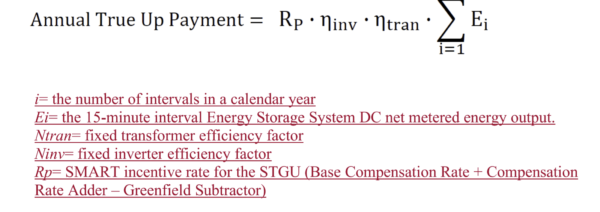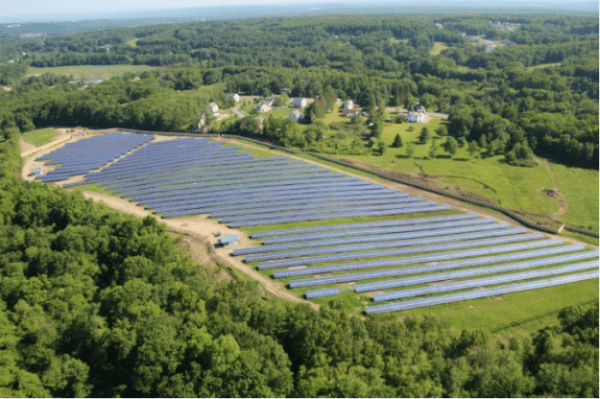The Massachusetts Department of Energy and Resources (DOER) released revisions and new public comment periods it works seeks to finalize the expansion of its Solar Massachusetts Renewable Target (SMART) Program.
The finalized energy storage guidelines state that if an energy storage project doesn’t run for 15% out of of a 52 week period, it will be disqualified for the whole year. If that level of performance occurs in a second year, then the project loses its SMART incentive entirely.
A second energy storage-related item includes a technical financial “true up” on DC coupled solar-plus-energy storage. This true up takes into account current conversions as the electricity moves from solar production to battery storage and then to the power grid. Using the equation below, the state will calculate the financial difference once a year based on what is measured at the meter, and submit a payment to the project owner.

The changes also refine community solar incentives and maps, including a requirement for additional monthly and annual data, as well as updated maps of impacted populations.

Image: Community Energy Solar
The DOER also opened public comment periods on two items. The state will now use the online OLIVER Maps tool to determine prime farmland. Developers must also follow land use guidelines as the state seeks to protect more prime land from development.
According to some solar developers, these new limitations will remove 90% of Massachusetts land from solar development opportunities.
When the SMART program launched, pv magazine USA predicted that the National Grid portion would fill up immediately due to a build up of projects, and it did. National Grid suggested that this was a surprise as it put hundreds of megawatts of projects into long-term studies. The state later opened an investigation to determine the source of the failure.
The DOER has since moved forward by doubling the solar capacity of the SMART program. But as the article stated, these regulations have not been finalized. This leaves that same segment of the state partially on hold for the SMART program – along with the new solar construction that entails – while SMART II is finalized.
Predictably, these accounts – which have been put on hold – are growing in volume.
This content is protected by copyright and may not be reused. If you want to cooperate with us and would like to reuse some of our content, please contact: editors@pv-magazine.com.








The new 85% uptime rule is harsh but I kind of get it. Some people might be disabling their battery at opportune times to avoid excessive cycles and battery wear and MA SMART doesn’t want to play games.
I find the “True Up” payment amusing. It’s a tiny band aid on a huge bullet hole. The MA SMART requirement for a separate utility meter to measure generation instead of a revenue grade inverter is inexcusable. It made installing the inverter in my basement significantly more difficult and time consuming. For those of us with a SolarEdge StorEdge inverter that feeds a dedicated backup loads panel, the energy used by the loads on the backup panel bypass the SMART utility meter. In my case, I have two refrigerators, a freezer, two gas furnaces, and a gas on-demand water heater on the backup loads panel. It’s impossible to quantify the incentive loss due to the SMART meter bypass.